MXA RACE TEST: THE REAL TEST OF THE 2021 HONDA CRF450
MXA RACE TEST: THE REAL TEST OF THE 2021 HONDA CRF450
Q: FIRST AND FOREMOST, IS THE 2021 CRF450 BETTER THAN THE 2020 CRF450?
A: Make no mistake about it, the 2021 Honda CRF450 is a better all-around race bike than the 2020 CRF450, but with several deal-breaker caveats! Most important, MXA does not believe that Honda actually finished the R&D stage of testing the 2021 CRF450. Honda left that up to you (as an unpaid consultant).
Q: WHAT DOES BEING AN “UNPAID CONSULTANT” MEAN?
A: It means that somewhere between the prototype phase and production phase, Honda’s engineers stopped working on the setup of the 2021 CRF450. Based on decades of R&D experience, we know there is no way that every Honda engineer and test rider could have signed off on the 2021 CRF450 project. We say this because the 2021 Honda CRF450, as it was when handed to us, was a blatantly unfinished project. We are willing to bet that there were concerned people working on the 2021 CRF450 project who voiced their displeasure that the bike was going out the door without Honda fixing the obvious flaws. We are also willing to bet that anyone who spoke up was most likely removed from the decision-making process. How do we know that Honda stopped development before the bike was finished? Because we rode it, raced it and tried to fix it, and we wouldn’t have signed off on it the way it showed up at the dealerships. This is a great three-quarters of a motocross bike. The other quarter is so far off that it can only be explained by benign neglect at the factory level.
Unless Honda steps up to the plate to help 2021 Honda CRF450 buyers, they will be on their own to find solutions to the most obvious problems.
Q: HOW COULD HONDA MAKE MISTAKES ON A BIKE THEY HAD FOUR YEARS TO DEVELOP?
A: Because they have done the exact same thing on the last three “first-year” models (2009, 2013 and 2017). Most racers know that the 2008 Honda CRF450 was an awesome machine, but Honda’s young engineers in charge of designing the 2009 CRF450 had a totally new idea for the 2009 model. They experimented with geometry that was different from any other motocross bike ever made. It was called the “Cab Forward Design,” and it was not popular, and it didn’t help that it was paired with Honda’s horrid four-spring clutch and had oversteer/understeer/oversteer frame geometry, flame-out issues, auto-compression release failures and flat top-end power. The 2009 first-year model was a terrible bike, and it stayed terrible for the complete four-year cycle (2009–2012).
In 2013, Honda had to address four years’ worth of complaints about the 2009–2012 CRF450s. The 2013 CRF450 got a new frame to get rid of the ill-conceived Cab Forward geometry and added help in the form of a six-spring clutch, new cam profile, larger exhaust valves and increased compression. All well and good, but the 2013–2016 CRFs were ruined by two ideas: (1) Honda’s engineers instituted their infamous “slower is better” philosophy. In short, that meant the 2013–2016 CRF450s would give up as much as 5 horsepower to the competition. (2) Honda jumped on the air fork bandwagon with the overly complicated, hard-to-adjust, and consumer-mystifying Kayaba PSF air forks and kept them on the CRF450 for four distressing model years (2013–2016).
In 2017, Honda got a chance to retreat from the “slower is better” philosophy and the unfathomable PSF air forks. As an R&D goal, the engineers tried to take a close look at the 2008 CRF450 and build a 2017 version of it. Unfortunately, it wasn’t right from the start, and Honda had to make constant changes for the next three years—those included electric starting, less herky-jerky mapping, flexier head stays, an extra scavenger pump, a new cylinder head, revised shock linkage, more mapping changes, a new front caliper, larger-diameter exhaust pipes and more new mapping (with the three-push-button multi-controller). Honda’s “slower is better” experiment came to a definitive end with the 60-horsepower 2019 version. All in all, this four-year cycle (2017–2020) ended up producing the best Honda CRF450 since 2008, but the first model year, 2017, needed a lot of remedial help.
As you can see, the old adage, “Never buy a first-year model,” could well be Honda’s mantra.
Q: IS THE 2021 HONDA CRF450 AS BAD AS EVERYONE IS SAYING?
A: No. It has the raw material to be a terrific race machine. Every single piece of the bike was changed for 2021—little to nothing remained of the 2020 CRF450, but, by the same token, motorcycle design departments have an inherent genetic DNA-strand that makes all of their new bikes have a striking similarity to their old bikes. We don’t want to take up valuable test time to make a massive list of all the newness, we’d rather tell you what those changes mean on the track in terms of suspension, handling, power, ergos and improvements.
However, since you asked, here is a quick list of what they did wrong in 2021: (1) Because of a virtually untested ECU, the mapping can be ratty at low rpm (although not for every riding style). (2) The forks are way too soft and lack adequate compression damping. (3) The shock is sprung for a 150-pound rider, but most 450 riders are in the 180-pound range. (4) It overheats in long, hard motos and sometimes on the starting line. (5) It has 11 different maps, launch control and traction control options. It makes you dizzy trying to remember them. (6) The handling is very Honda-like, meaning that it headshakes at speed and turns-in great but oversteers on corner exit. (7) Finding the proper fore/aft balance on the 2021 CRF450 is a full-time job. (8) Honda has a bad track record with first-year models, and we don’t think that R&D on the 2021 CRF450 was finished before they pushed it out the door.
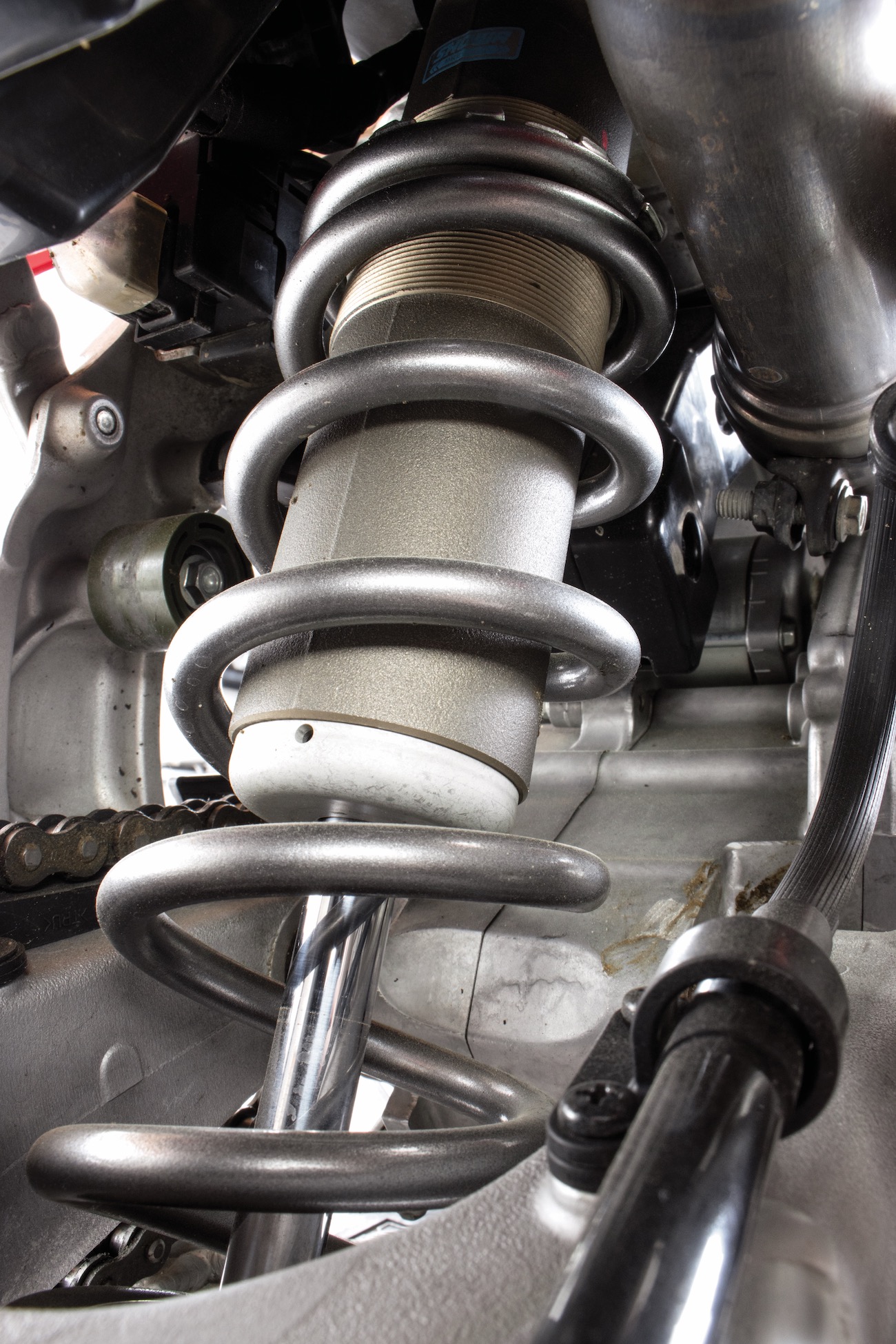
Q: HOW DOES THE 2021 HONDA SUSPENSION WORK?
A: It isn’t very good. Honda’s in-house test riders must have complained to the engineers and product managers about the stock setup. It is so far off that if the test riders didn’t know how wrong it was, then Honda needs to find new test riders. This is a pure-bred motocross bike with play-rider suspension.
49mm Showa coil-spring forks. Ever since Honda backed away from air forks and returned to coil-spring forks, its forks have been less than stellar. Even though they share the same basic Showa fork with Kawasaki and Suzuki, none of the three have come close to Yamaha’s SSS forks or WP’s Xact air forks. And the 2021 forks are the worst of the Showa bunch. Not only are the fork springs too soft, there is a total lack of mid-stroke compression damping. The forks hold up initially, but any size bump, jump landing or hard braking will cause the forks to blow through their mid-stroke and bottom hard. We went in on the compression clicker, but if we went too many clicks in we opened up a world of hurt.
The MXA test riders resorted to stiffer fork springs, which held the forks up higher in the stroke; however, springs can’t fix valving errors. We tried raising the oil height to increase compression damping late in the stroke, but we would have had to fill the forks with oil to get them to slow down enough to stop diving. Not helping the soft forks is that Honda steepened the CRF450 head angle, which puts more pressure on the front end. For 2021, Honda lengthened the forks by 5mm to fight their stinkbug reputation. There are tracks, rider weights and skill levels where the Honda fork works very well, much like the 2020–’21 Kawasaki forks, which are also too soft. They can work well on smooth tracks, for light riders or for riders who don’t travel at speeds that load the forks constantly. Eventually, we cracked and sent the forks out to be re-valved. That fixed the fork problem, but it wasn’t cheap.
Showa shock. Last year we ran the shock’s race sag in the 107mm to 108mm range to help balance out the chassis; but, when we dropped the race sag on the 2021 CRF, the shock resisted it. It turns out that Honda exchanged last year’s 56 N/mm shock spring for a 54 N/mm spring. The softer spring and the extra-low race sag were a bad combination. The best race sag was 100mm to 105mm, because it stopped the shock from wallowing and feeling stagey throughout its stroke. As always, the Honda delivered an out-of-balance feel in stock trim. We elected to go back to the 56 N/mm spring from 2020. This enabled the low-speed compression clicker to be used a little less while feeding in more rebound at the same time. It unfortunately was too stiff or riders under 150 pounds-who needed the 54 N/mm spring. The CRF450 rear shock works well at low speeds and in bumps that don’t stress it very much, but once you push the shock harder, it will G-out on the backside of bumps, jumps and whoops. Worse yet, it kicks in square-edge bumps.
Q: HOW DOES THE 2021 HONDA HANDLE?
A: Overall, the frame is one of the most improved aspects of the Honda in the last 12 years. Lateral rigidity has been reduced a remarkable 20 percent, which can be felt in everything from line choice to directional changes to accurate wheel tracking. With the old frame, you were never sure what it was going to do in the rough. Its rigidity was not a good match for its hard-hitting, ultra-aggressive, explosive, 60-horsepower engine. No doubt about it, the 2021 Honda’s more conservative powerband, flexier frame and spot-on ergonomics will make every loyal Honda CRF450 rider a happy camper (and there used to be a lot more Honda loyalist before 2009’s Cab Forward design drove them away).
The 2021 Honda CRF450 is best at turn-in, where it can carve a tight inside line with Suzuki-like accuracy. This is the Honda chassis’ best trait and makes the 2021 CRF450 fun to ride; however, it is its only great trait. It is possible to have too much of a good thing. For some unknown reason, Honda’s engineers steepened the head angle by 0.5 degrees, ostensibly to make the CRF450 turn-in better. We would never have thought of steepening the head, especially given the CRF450’s infamous head shake issues at speed.
There was a corollary side effect to Honda’s incredible turn-in prowess. When you combine the steeper head angle with the soft forks and aggressive braking, you get a bike that dives. The dive steepens the head angle way beyond common sense. This tacks the CRF450’s front tire to the ground so well that the frame hinges in the middle and the rear end steps outs. This is not an issue in loam, sand or berms, but it can be very distracting on loose dirt on hard, hard dirt on hard, wet dirt on anything, off-cambers and tricky left/right transitions. Every MXA test rider had one or two corners on his favorite tracks where he looked like a Grand National dirt track racer at Peoria. This was a twitchy bike on corner exit, as the rear seemed to be attached by bar room door hinge and setting It up as a continuous circle of changes to the fork wreaking havoc on the shock and vice versa.
One handling trait that has always been a part of Honda’s DNA is head shake. The rougher the track and the faster the rider, the more the frame had a mind of its own. The 2021 frame is better, but the steep head angle and soft suspension erase all of the frame’s beneficial attributes at speed. Slower riders get in less trouble than Pro riders; however, no matter who was on board, there was enough busyness at speed to convince sane men to slow down.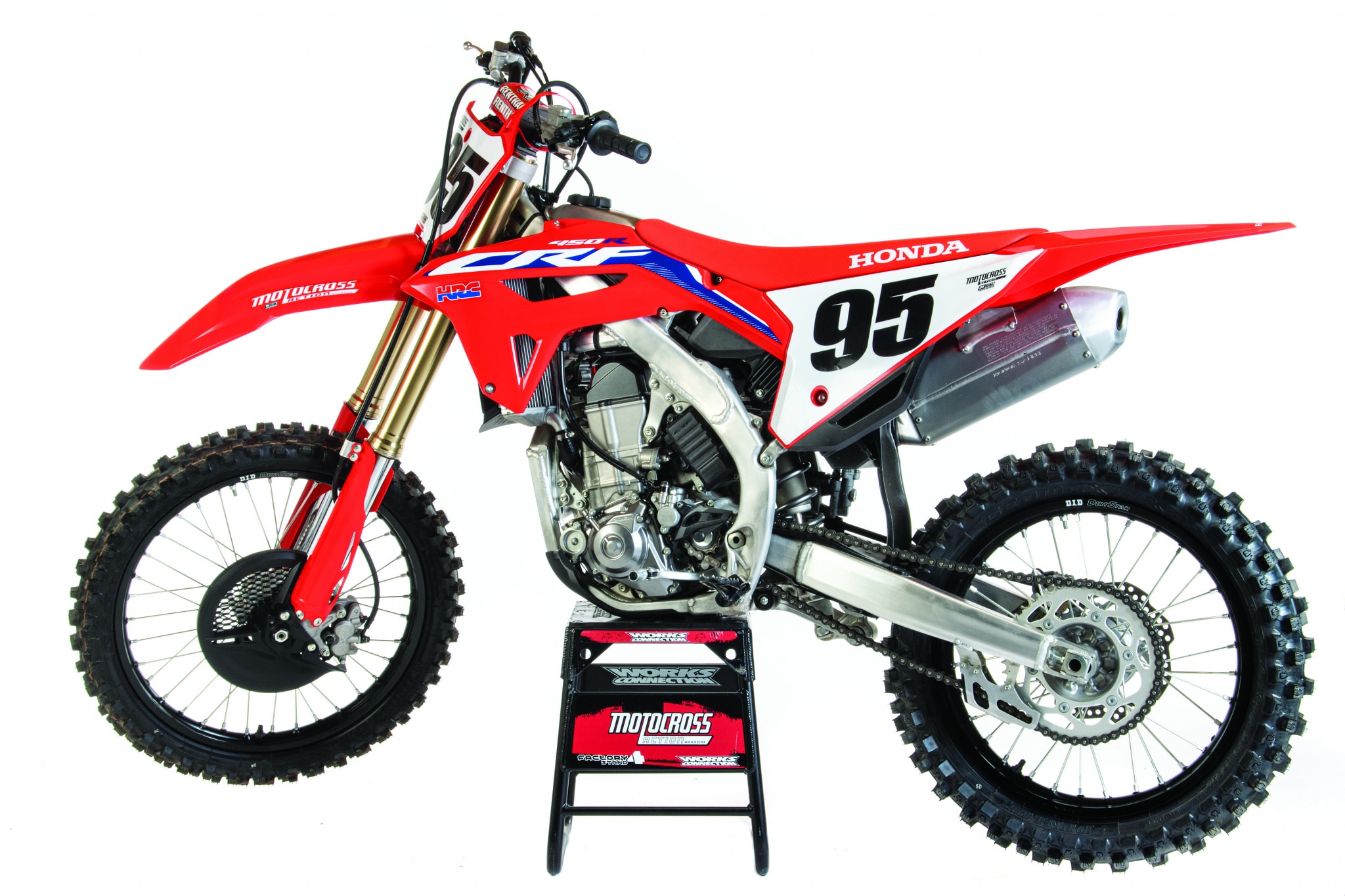 The 2021 Honda CRF450 is lighter, narrower, less rigid and better equipped than the 2020 CRF450.
The 2021 Honda CRF450 is lighter, narrower, less rigid and better equipped than the 2020 CRF450.
Q: HOW FAST IS THE 2021 HONDA CRF450?
A: We love this engine. Unlike the mellowed-out powerplants of 2009 through 2016, or the hyper engines of the last couple years, the 2021 engine is more refined and less aggressive. It has a linear powerband that builds its thrust steadily from way down low (with caveats) to way up high. There is no need to floor it, punch it or hammer it; just let it pull. The old slow engine had CRF450 riders going “giddy-up” in hopes of staying with the competition. The brutal 60-horse engines of 2019–’20 had CRF450 riders going “Whoa” when a jolt of power rocked them back in the saddle. The 2021 engine will have Honda CRF450 riders going “Hi Ho Silver, Away” as it turns noise into acceleration.
If we were to compare the 2021 Honda CRF450 to any other engine, it would be the 2021 KTM 450SXF. The Austrian bike has the ultimate linear crescendo-style of power. No burst of power, just an ever increasing flow of usable power.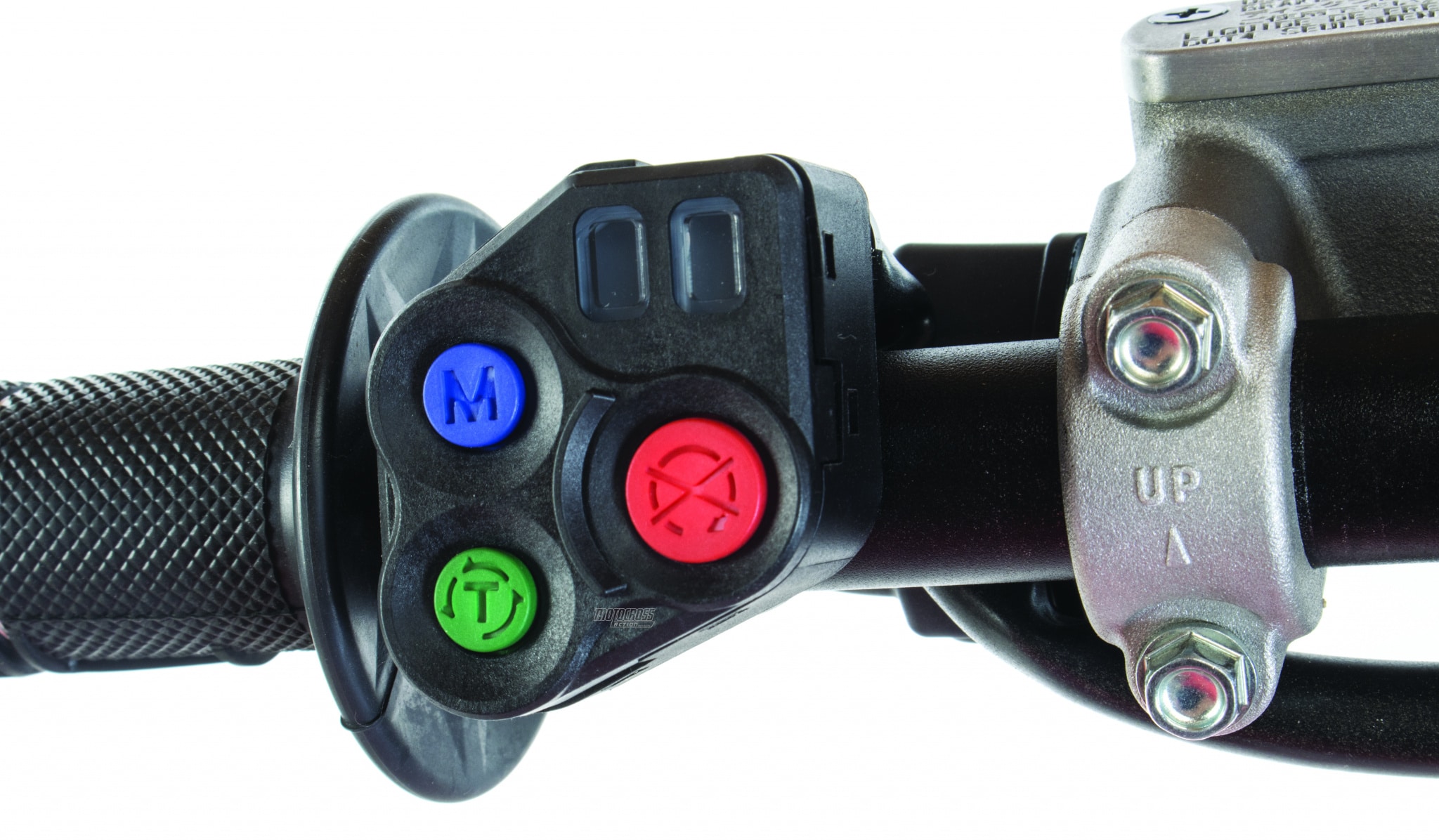 The handlebar map switch looks like a video game controller but it is more complicated.
The handlebar map switch looks like a video game controller but it is more complicated.
Q: OH YEAH, WHAT ABOUT THOSE POWERBAND CAVEATS?
A: The first batch of 2021 Honda CRF450s shipped into the USA had serious mapping issues that manifested in five ways.
(1) First, the 2021 CRF450 wouldn’t run clean down low. It huffed and puffed at small throttle settings. It ran ratty at low rpm, when riding through the pits, exiting tight turns, when trying to modulate the power to keep the engine churning at low speeds or blipping the throttle to set the power up for the next obstacle, especially in deep dirt, sand or bumpy terrain. Once you came to the realization that the engine was going to stumble, you had to wick it up quickly to jump over the mapping glitch. As bad as the mapping was at low pm, it was excellent above the rough spot. It made every tight corner into a talent test. Could you keep the revs out of the low-end? Could you clutch it fast enough to keep it from flaming out? Could you live in constant fear?
(2) Second, the other track situation where the erratic mapping could cause trouble was at the end of a long fast straight when you chopped the throttle to glide into the upcoming turn. When you shut the throttle off, regardless of how fast you were going, you were often greeted with silence. It was as though the engine had turned itself off. It was shocking, and if you didn’t act fast, the engine would flame out (also a long-standing issue with the CRF450’s DNA). A quick clutch hand and a blip of the throttle were required.
(3) Third, there were MXA test riders who claimed that the mapping only stumbled in map 1 (stock) and that it didn’t do anything wrong in map 3 (aggressive). Of course, map 2 had the same complaints. The big problem was that every test rider claimed that the stumble was worse in the map where another test rider said it didn’t exist.
(4) Fourth, every day during our test period, we expected Honda to call us about meeting them at the track so they could remap our 2021 CRF450. We assumed that by now Honda would have ordered its dealers to remap every 2021 CRF450 before it leaves the showroom floor and recall all the CRF450s that were in the first batch of bikes in the country. But, they didn’t call us with the news. Eventually, we gave our bike to Twisted Development’s Jamie Ellis so he could remap it for us. He used his dyno, oxygen sensor and computer to design us a vastly improved maps, which he installed in place of map 2 and map 3.
(5) Fifth, there are three maps, plus launch control and traction control. We like that the three maps are different from each other—and that the mellow map (map 2) is actually usable for a change. Traction control is the other button on the multi-switch, but in most cases we found that the distinct differences between map 1 (stock), map 2 (mellow) and map 3 (aggressive) made Honda’s traction control system only necessary on shiny hard-pack or mud. Launch control is activated by pressing the starter button before selecting one of three rev limiters. You read that right. Honda doesn’t retard the ignition mapping for launch control as everyone else does; instead, it changes the rpm setting of the rev limiter.
Q: HOW DO THE 2021 HONDA CRF450 ERGOS FEEL?
A: Compared to last year’s CRF450, the 2021 Honda is so much sleeker it is amazing. The right side number plate panel is 20mm narrower, while the left side panel, where it used to bulge around the muffler, is 70mm narrower. The exhaust pipe is much better tucked in from the head pipe to the muffler. The clutch and throttle cable are mounted a la KTM, which means behind the handlebars. The only ergonomic faux pas are that the seat height is 10mm taller, and that means that riders shorter than 5-foot-10 will not be able to touch the ground, and the hydraulic clutch hose looks like left-over garden hose and doesn’t fit sleekly under the tank.
Q: WHAT CHANGES DID WE ASK HONDA TO MAKE TO THE 2020 CRF450 FOR 2021?
A: The MXA wrecking crew has no power over what Honda changes on its new models. In our 2020 test, we gave them a list of the things we would change if we were in charge. Here is what we asked for.
(1) Weight. We wanted Honda to shave weight off of the 238-pound 2020 Honda CRF450. They did. The 2021 weighs 233 pounds, exactly what it weighed in 2017 when it didn’t have electric starting. That is a 5-pound weight savings over 2020.
(2) Twice pipes. We hate Honda’s twin pipes with a passion. They were a stupid idea that didn’t make more power, wasn’t quieter, weighed 3 pounds extra and cost 25 percent more to replace. Hallelujah! The twice pipes are history.
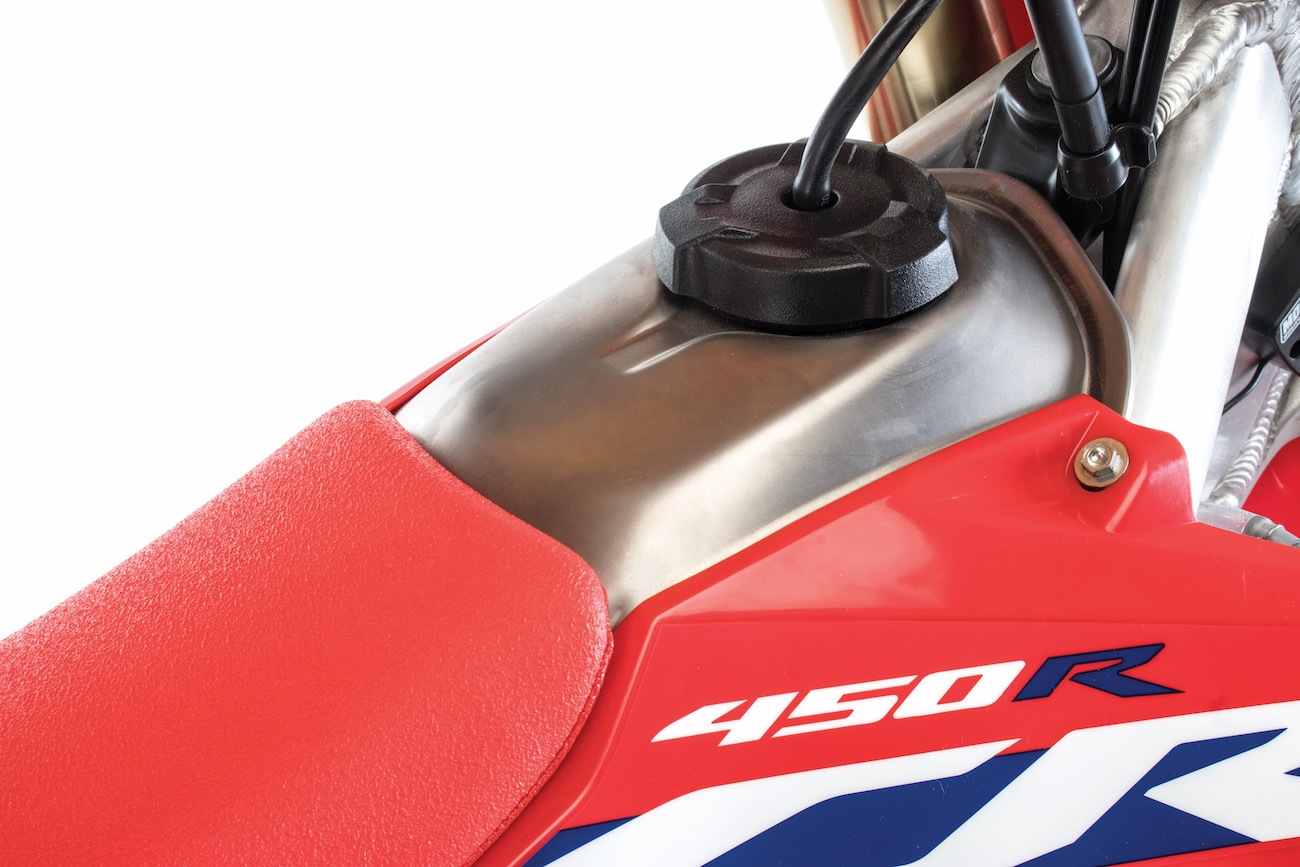
(3) Titanium gas tank. We didn’t mind that Honda made the gas tank out of titanium over the last few years, but we hated that Honda covered the titanium with black plastic. It was pointless to have a titanium gas tank and then hide it behind plastic. Guess what? The black plastic cover is gone in 2021.
(4) Radiator cap. When MXA’s 2020 CRF450 spewed water out of its radiator overflow, we swapped the stock 1.1 kg/cm2 radiator cap for a Twin Air 2.0 kg/cm2 radiator cap. Water still spews out of our 2021 Honda radiator, because Honda still spec’s a 1.1 cap.
(5) Clutch. Honda’s clutch has been weak since 2009, and, to make matters worse, it came with the less-than-stellar judder spring system. Thankfully, the 2021 clutch gets six springs, eight plates, no judder spring, hydraulic actuation and a 27-percent-larger capacity.
Q: WHAT DID WE HATE?
A: The hate list:
(1) Radiators. They boils water like a steam iron. We check the water after every long moto. Switch to a high-pressure radiator cap.
(2) Forks. The forks are too soft. They were too soft last year also. They offer harsh bottoming resistance, minimal mid-stroke compression damping and dive under braking.
(3) Shock. If you are light (below 150 pounds), the soft shock spring will be okay, but, if you are typical 450 size (above 150 pounds), it will wallow.
(4) Electronics. Someone was bound to take mapping, traction control and launch control too far. We doubt that very many racers have the patience to try all the settings. MXA tapes a crib sheet on our crossbar pad with all of the instructions for accessing the 11 settings. Even the electric-starter button does double duty.
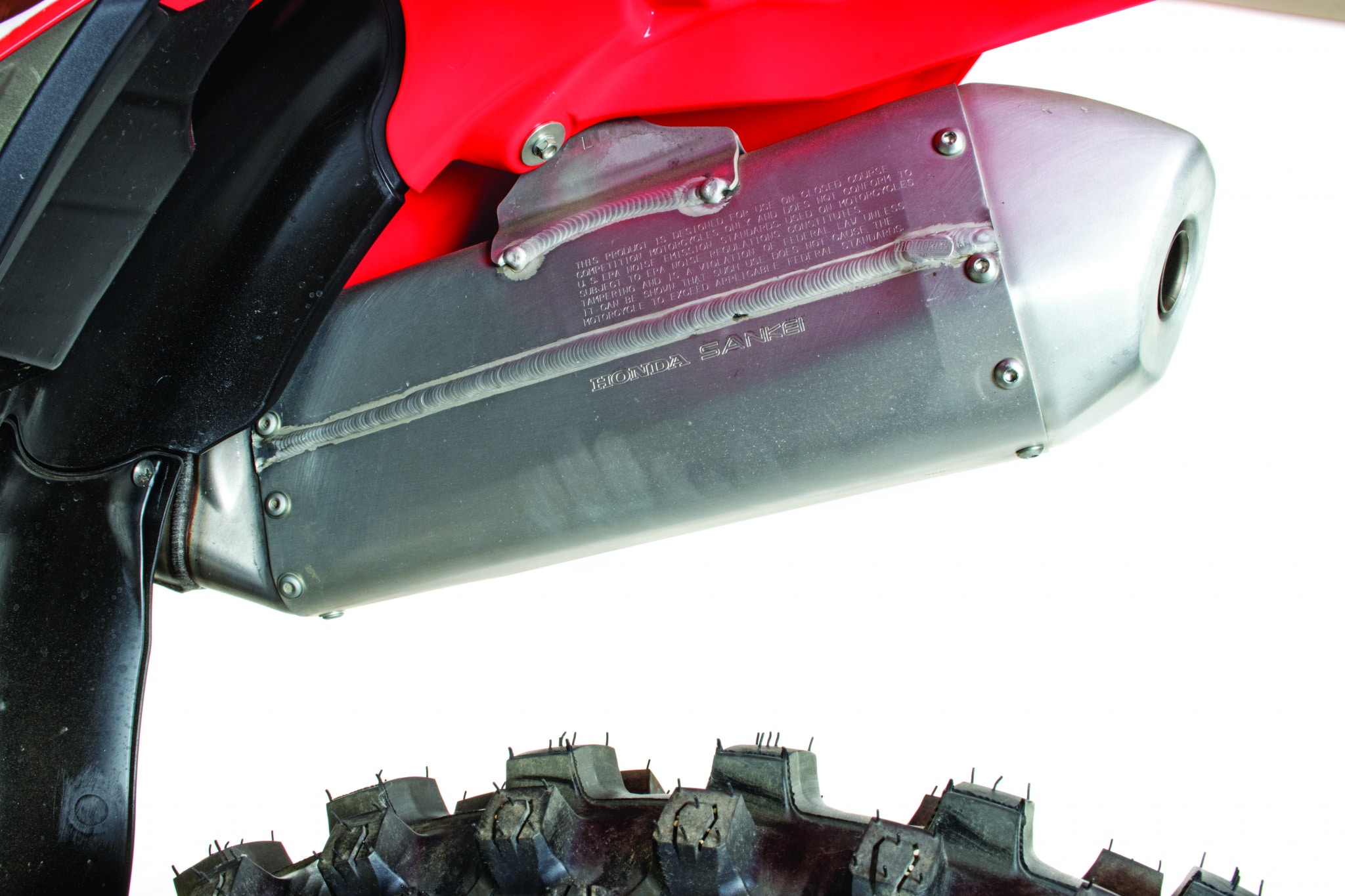
Q: WHAT DID WE LIKE?
A: The like list:
(1) Horsepower. In the last two years, we have been impressed with the quantitative amount of horsepower; for 2021, we were impressed by the qualitative horsepower.
(2) Ergos. Nothing is as well laid-out as a CRF450.
(3) Electric starting. It works (and you don’t have to pull the clutch in anymore).
(4) Maps. We like adjustable maps, especially when you can feel a big enough difference between each one. But, if you are bothered by the often ratty low-end, have it remapped.
(5) Gearing. The stock 13/49 gearing is in the ballpark, but we found ourselves wanting to go down to first in some corners and having trouble pulling third under a load, so we went from 49 teeth to 50 teeth.
(6) Airbox. The new Honda airbox is weird. It is upside down, and the foam filter is hooked onto the cage with way too many tabs, but it is easy to get to (one bolt), and even though it looks like it has less air volume, the air volume is four times larger than that of the 2020 airbox.
(7) Single pipe. Gee! Who would have guessed that a single-side exhaust would be almost 3 pounds lighter and make more torque than the twin?
(8) Shock clickers. Last year, the shock clickers were on the left side of the bike. This year, they are on the right where they belong.
Q: WHAT DO WE REALLY THINK?
A: We loved the engine, and managed to live with the small mapping gaffe until we could get it reampped. We liked the ergos save for the seat height. We appreciated the engineering that went into the 2021 CRF450. But, and this is a big but, if it were us, we would wait for the second production year of the new Honda CRF450. Why? History proves that Honda will fix most of the first year models’ blunders in years two, three and four.
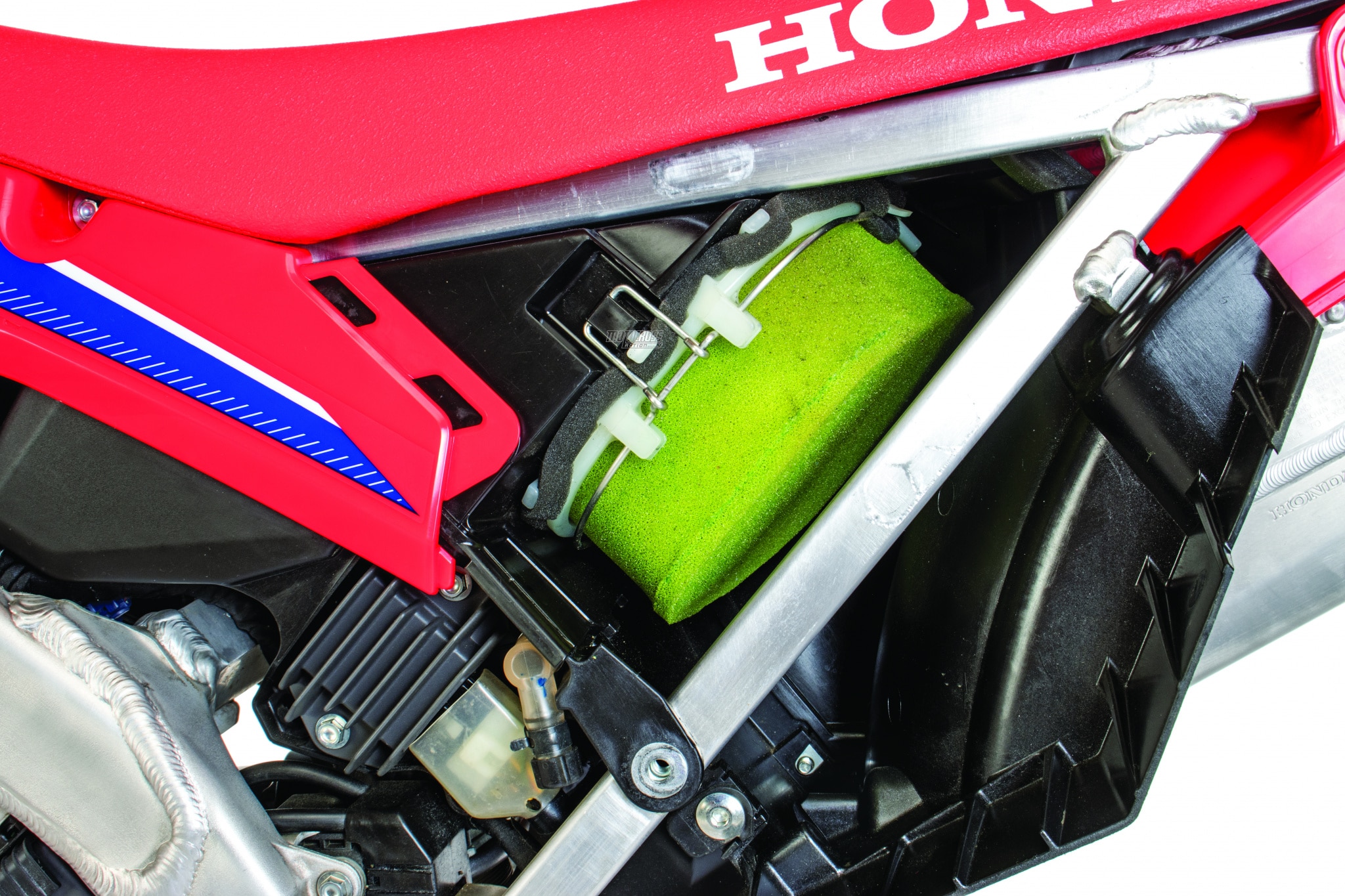
MXA’S 2021 HONDA CRF450 SETUP SPECS
This is how we set up our 2021 Honda CRF450 for racing. We offer it as a guide to help you find your own sweet spot.
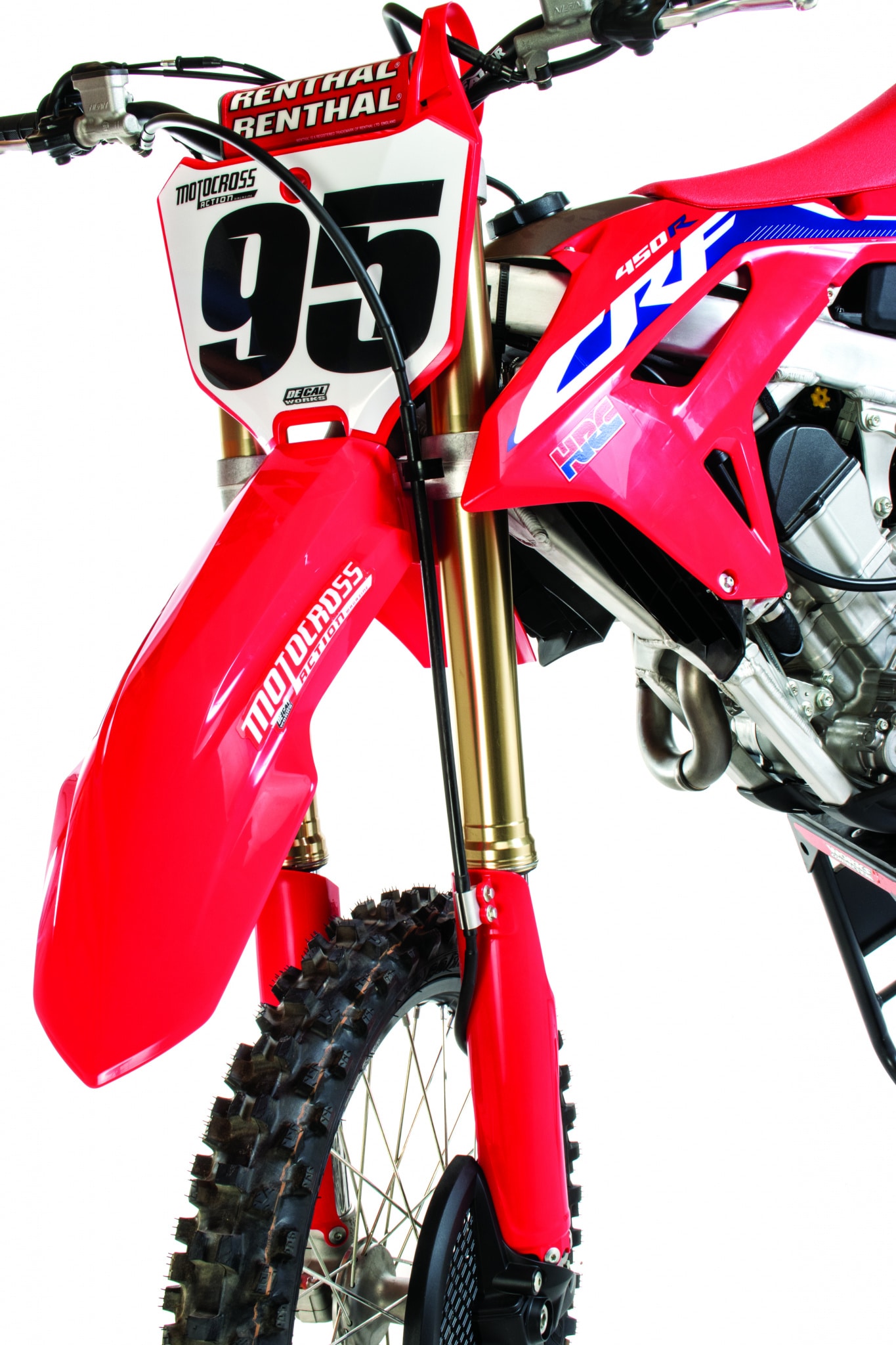
SHOWA COIL-SPRING FORK SETTINGS
Test riders turned the compression clicker in to try to make the fork feel stiffer, but if you went beyond five clicks in, the forks got worse. For hardcore racing, these are MXA’s recommended 2021 CRF450 fork settings (stock settings are in parentheses):
Spring rate: 5.0 N/mm
Compression: 10 clicks
Rebound: 15 clicks out
Fork-leg height: Flush with stock fork (even though they are 5mm longer).
Notes: Don’t over-crank the compression clicker if you are looking for a firmer feel. We had issues with the overly soft feel on bumps and jumps and a very harsh feel at full stroke. We could not iron this out with the clicks available to us. You have to experiment for your weight, speed and track conditions.
SHOWA SHOCK SETTINGS
We originally set the race sag at 108mm to mimic what we had done on our 2021 Honda CRF450. That was a mistake. The stock 54 N/mm spring was too soft to run with very low race sag. The 2021 CRF450 is very sensitive to fore/aft balance changes. We started with the low-speed compression at 12 clicks out and the rebound at seven clicks out. If the shock G’ed out in dips and on jump landings, we turned the high-speed compression dial in. The stock high-speed compression is two turns out. With the heavier 56 N/mm spring, we ran a little less low-speed compression and more rebound. For hardcore racing, these are MXA’s recommended 2021 CRF450 shock settings:
Spring rate: 56 N/mm
Race sag: 107mm
Lo-compression: 12 clicks out
Hi-compression: 2 turns out
Rebound: 8 clicks out
Notes: If you are heavier than 150 pounds, switch back to last year’s 56 N/mm spring.


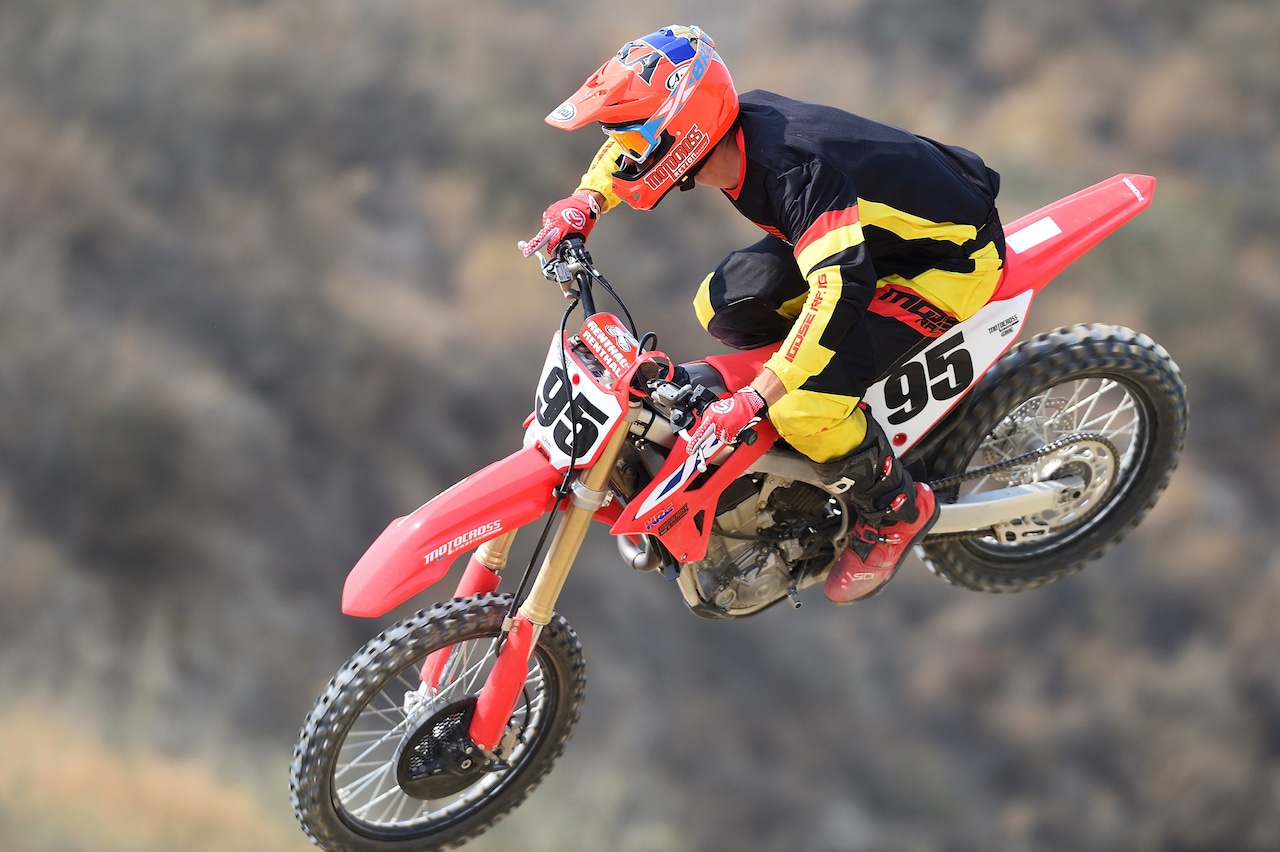
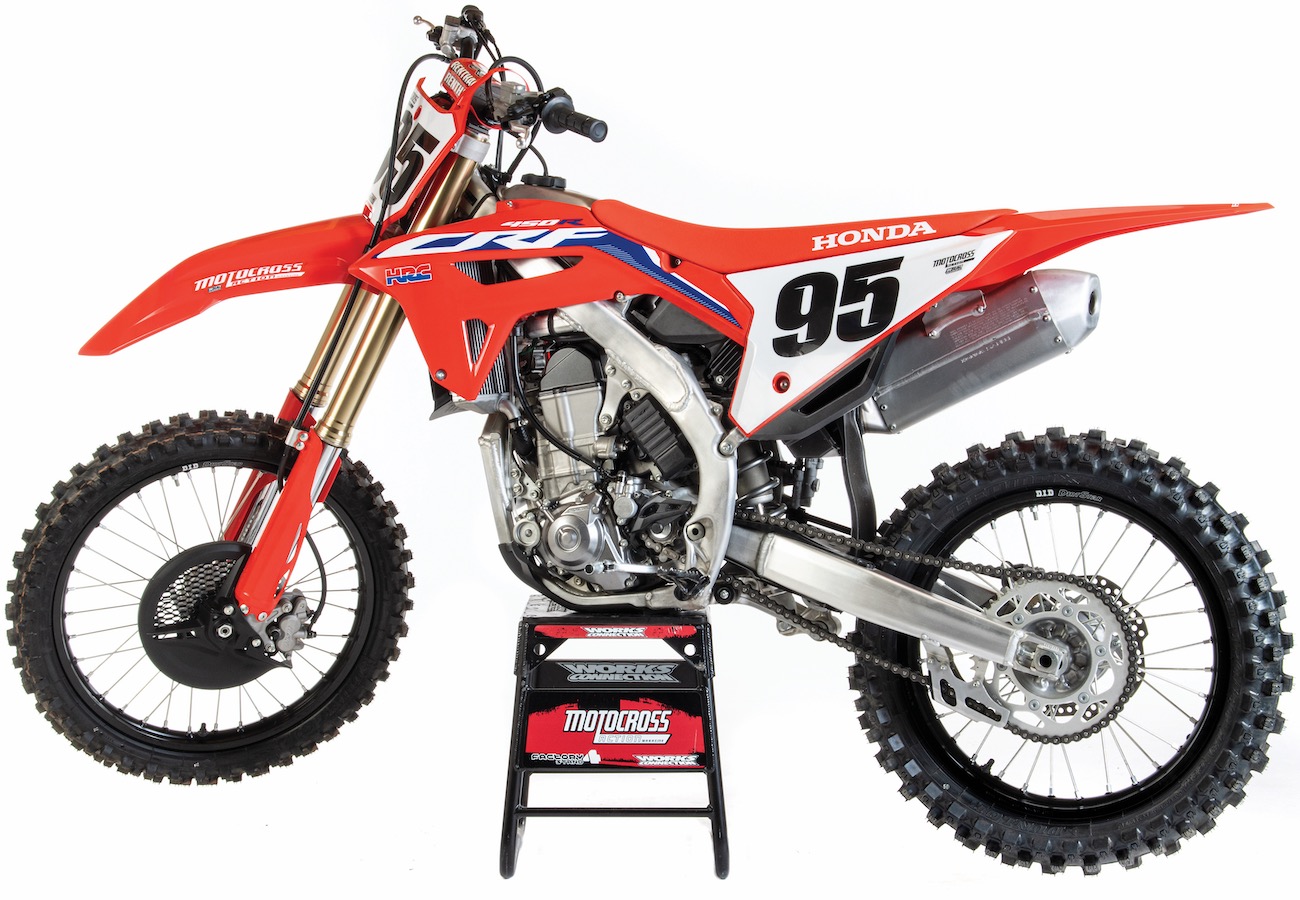
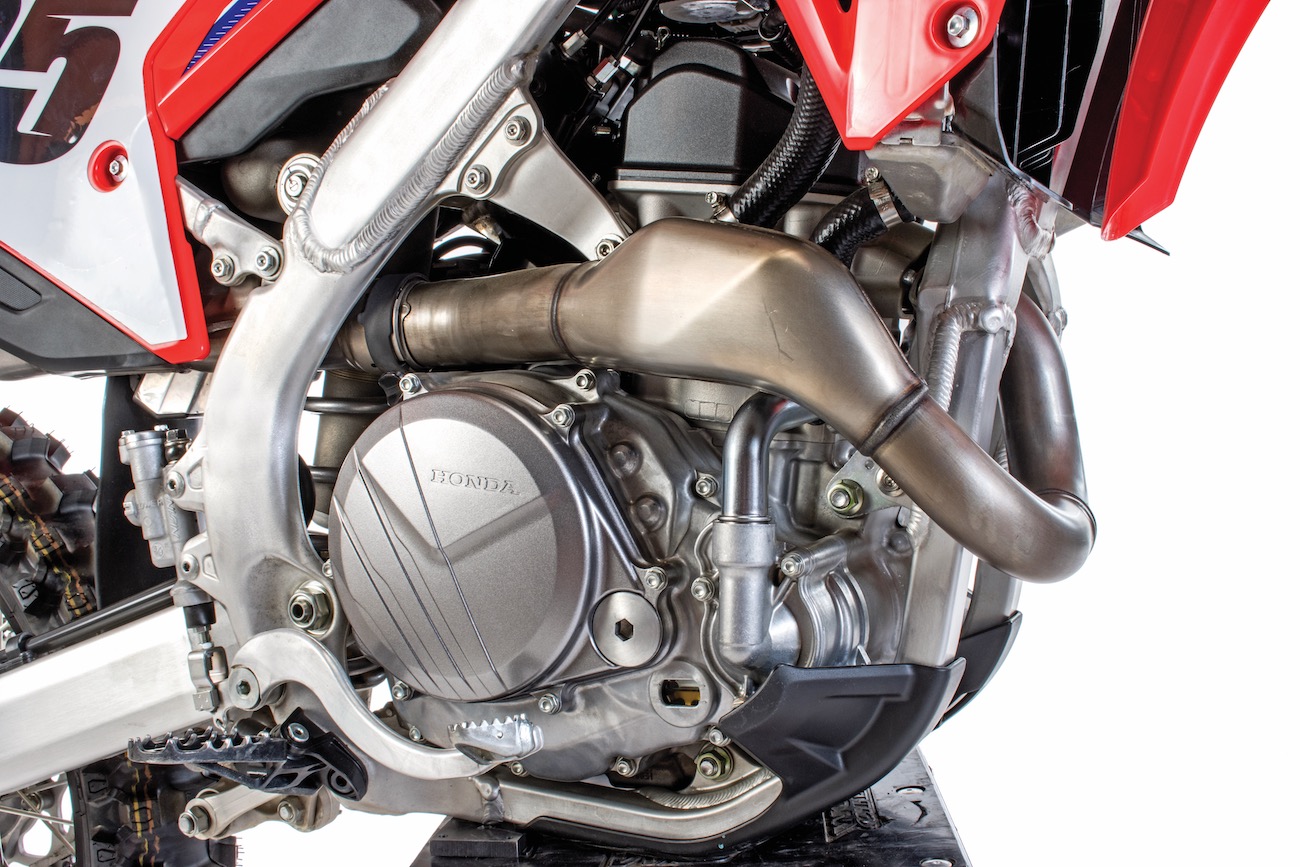
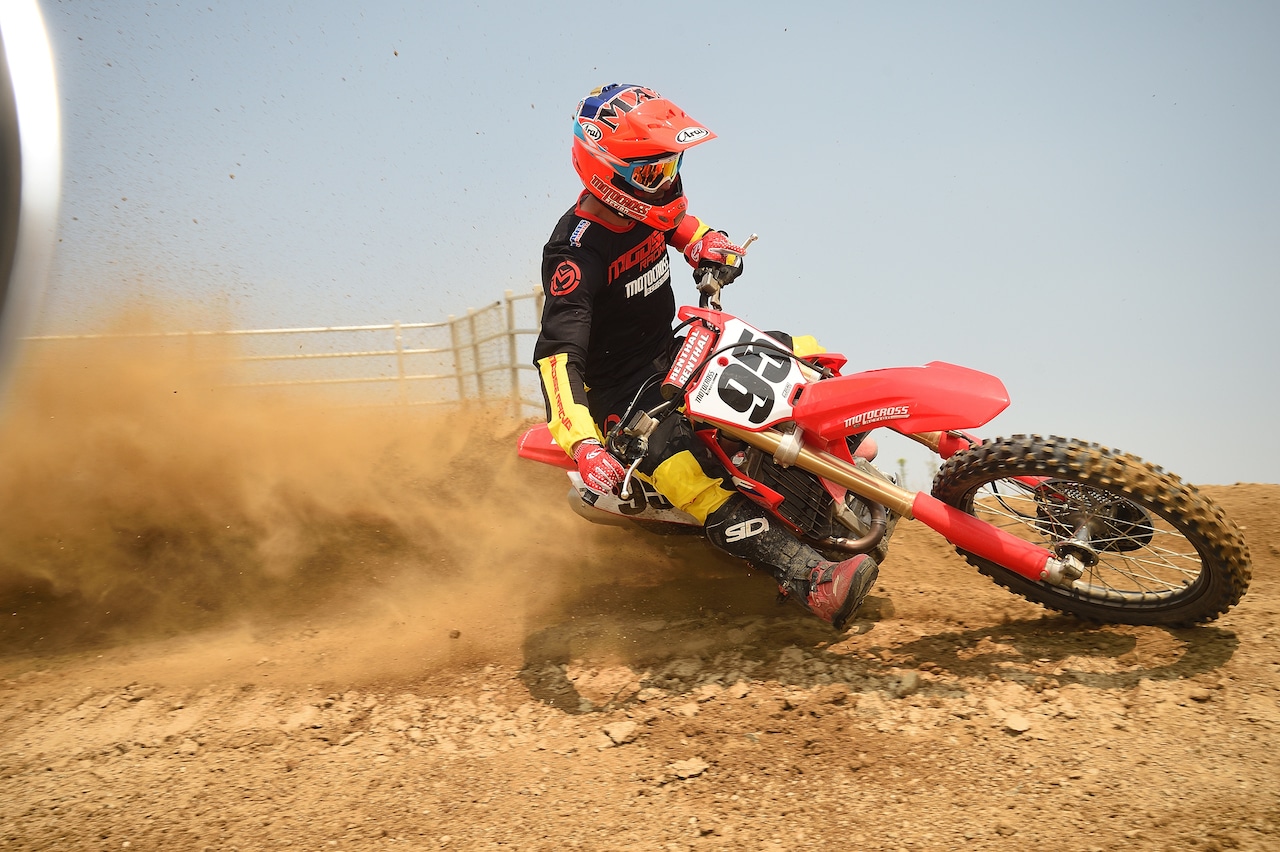
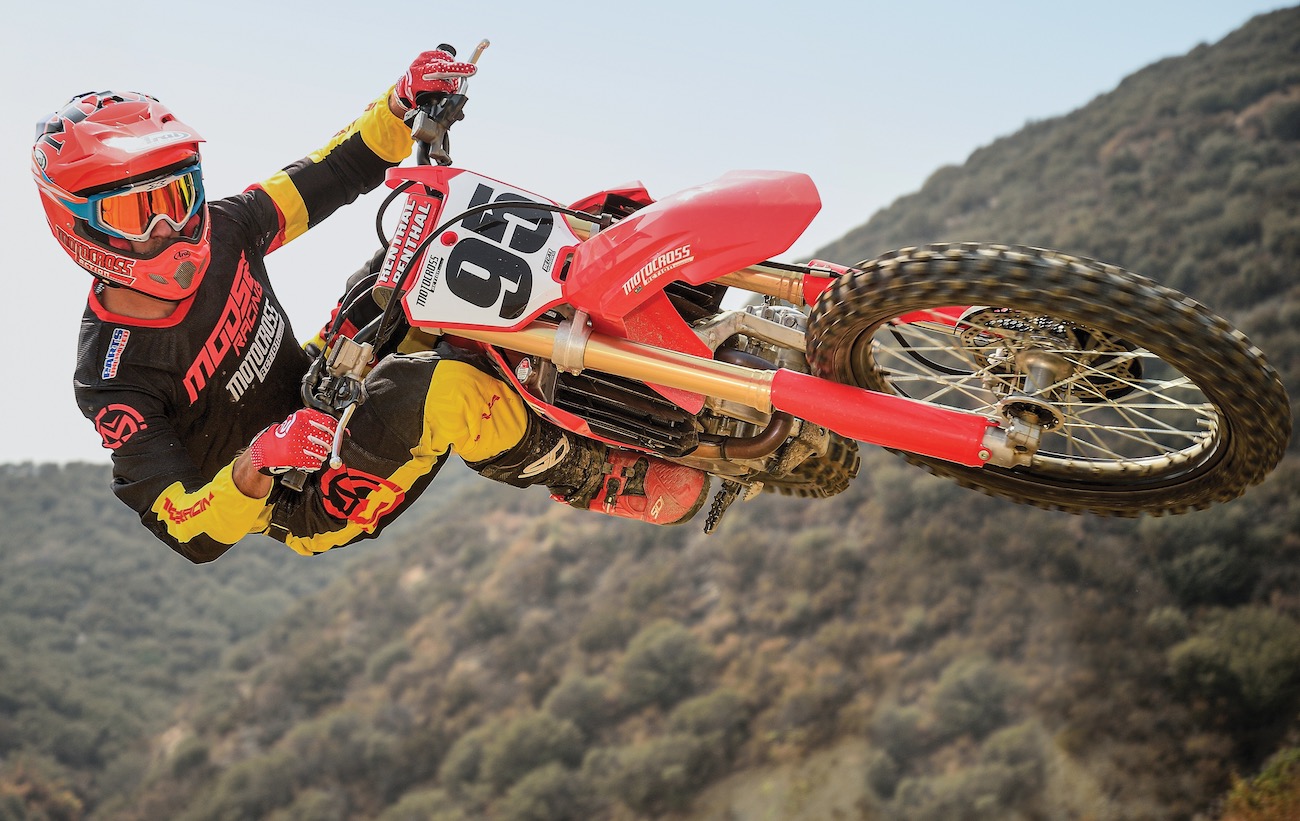

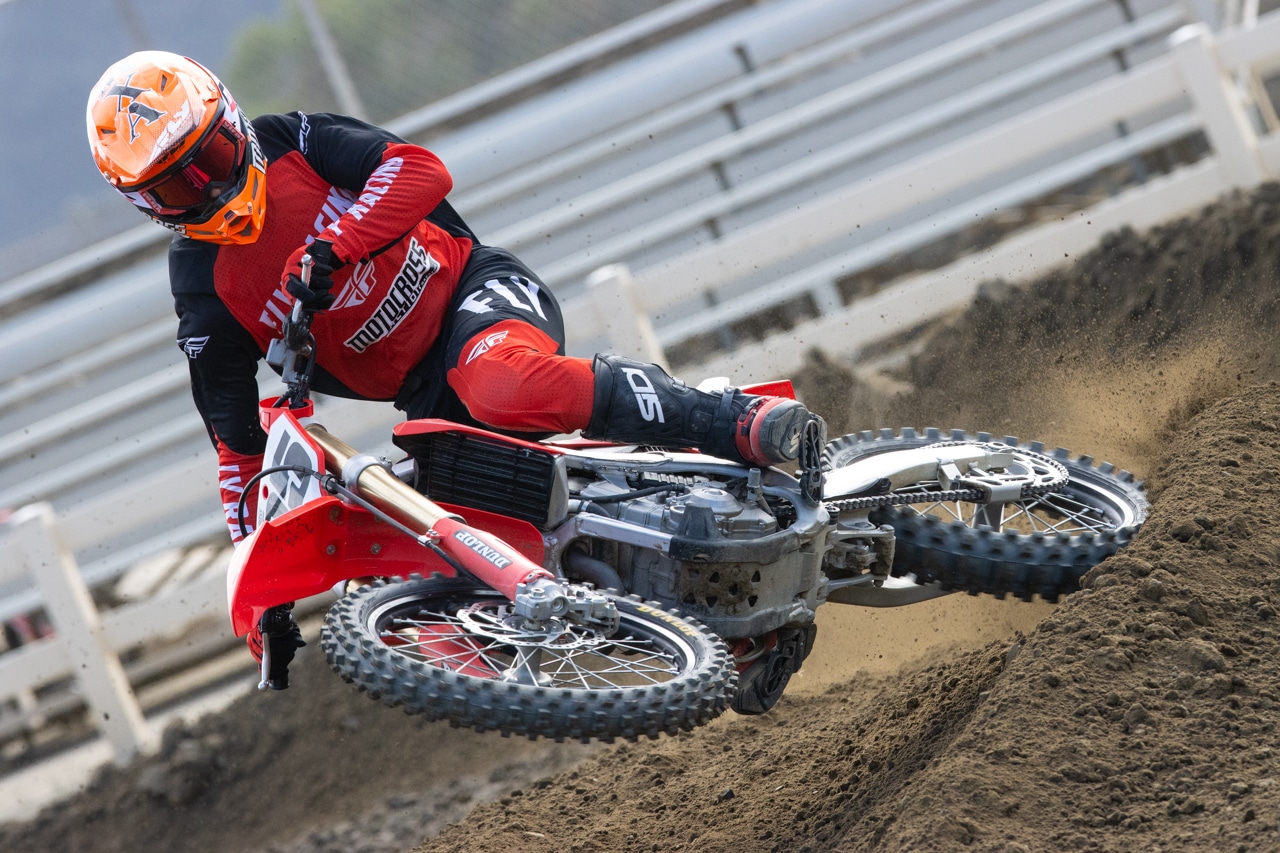



Comments are closed.